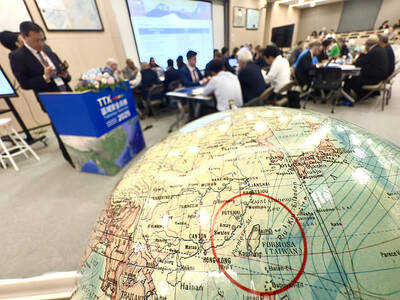The nation’s shoreline has been eroding over the past three decades, sometimes at a rate of more than 15m per year, academics said.
Numerous fishing wharfs dotting the coastline are the primary cause of shoreline erosion as they have caused a “jetty effect,” said Ling Tsung-yi (林宗儀), an assistant professor of geography at National Taiwan Normal University who was commissioned by the Central Geological Survey to conduct research on changes to the nation’s coastline.
The “jetty effect” refers to hard coastal structures — such as jetties and breakwaters — placed on sedimentary coastlines, which causes erosion of the down-drift shoreline.
The research team conducted the study by overlaying a photo of Taiwan’s shorelines taken in 1978 with a satellite photo taken in 2009, for the first time showing how much the shoreline has receded in 31 years.
A common feature wherever shorelines have receded is that the northern edge of the receded area has dikes perpendicular to the shoreline, which has caused sand to deposit north of the dikes and form beaches, but resulted in erosion to the south, Lin said.
Eroding shorelines have been observed at beaches near the Tatan Power Plant (大潭電廠) in Taoyuan County, the Hsinchu fishing wharf, the Jincheng (金城) and Siangshan (香山) coastlines and Lungfung Port (龍鳳港) in Hsinchu County.
The erosion rate south of the Tatan plant was as high as 6.2m per year.
At the Jincheng to Siangshan areas, the report found that heavy sand extraction from riverbeds in recent years had disrupted the sand balance. The extension of breakwaters at Hsinchu Harbor has cut off sand deposit to the southern shores of the two areas, causing erosion rates at the Jincheng area of up to 15.4m per year, with a total of 500m during the past three decades.
Lin said that stretching the timeline of the study over 30 years clearly showed progressive erosion of the western coastline.
While the eastern shorelines does not exhibit such evident erosion, breakwater reefs erected along the east coast to protect road foundations along Highway No. 11 point to the present danger of shoreline erosion, Lin said.
Statistics from the Council of Agriculture show there are 225 fishing wharfs across the country, with 139 in Taiwan proper.
Compared with the total length of the nation’s coastline, which spans 1,349km, there was roughly one fishing wharf per 9.7km, statistics showed.
Writer and nature enthusiast Liu ko-hsiang (劉克襄) said the density of fishing wharfs and breakwaters in Taiwan is probably a world record.
Green Formosa Front (GFF) said there were multiple factors causing coastline erosion, including changing weather patterns, rising sea levels, blockage and extraction of sand deposits, overpumping of groundwater causing land subsidence and the felling of windbreaks, which has caused sand to be blown inland.
The illegal extraction of riverbed sand and construction of tourism facilities and restaurants on former windbreaks pointed to a failure of land planning policies, GFF acting director Lin Chang-mao (林長茂) said.
The Tatan coastal area once had a thriving and self-sufficient ecosystem and was a breeding ground for sharks and rays, Lin Chang-mao said, adding that after the “jetty effect” began following construction of the power plant, sand deposits covered and killed off vast patches of algae that were a source of food for aquatic species.
It is now rare to see sharks and rays in the area, Lin Chang-mao said.
Chien Lien-kwei (簡連貴), dean of the department of harbor and river engineering at National Taiwan Ocean University, said one of the major reasons contributing to receding coastlines was the increase in extreme weather patterns.
Using the Fulong coastal region in New Taipei City (新北市) as an example, Chien said Fulong beach’s shoreline was receding because of an overabundance of extreme weather patterns and a decrease in sand deposited by Shuangsi River (雙溪河), as well as a “jetty effect” caused by nearby breakwaters and the pier of the Fourth Nuclear Power Plant.
Chien said abnormal weather patterns had increased typhoon erosion rates on beaches and the construction of reservoirs has stopped rivers from depositing sand in river deltas, causing shores to erode.
The government should actively monitor water depths and ocean weather patterns, Chien said, adding that officials should also implement “beach growing” policies to keep beaches from disappearing.
ADDITIONAL REPORTING BY WU LIANG-YI AND TANG JIA-LING TRANSLATED BY JAKE CHUNG, STAFF Writer

A Taiwanese software developer has created a generative artificial intelligence (AI) model to help people use AI without exposing sensitive data, project head Huang Chung-hsiao (黃崇校) said yesterday. Huang, a 55-year-old coder leading a US-based team, said that concerns over data privacy and security in popular generative AIs such as ChatGPT and DeepSeek motivated him to develop a personal AI assistant named “Mei.” One of the biggest security flaws with cloud-based algorithms is that users are required to hand over personal information to access the service, giving developers the opportunity to mine user data, he said. For this reason, many government agencies and

The National Fire Agency on Thursday said a series of drills simulating a magnitude 8.5 earthquake would be held in September to enhance the government’s emergency response capabilities. Since earthquakes cannot be predicted, only by continuously promoting disaster prevention measures could Taiwan enhance its resilience to earthquakes, agency Director-General Hsiao Huan-chang (蕭煥章) said in a news release. The exercises would be held to mark annual National Disaster Prevention Day on Sept. 21, the aim of which is to test Taiwan’s preparedness and improve its earthquake resilience in case of a major temblor, Hsiao said. As part of those drills, an earthquake alert would

DEFENSE: The National Security Bureau promised to expand communication and intelligence cooperation with global partners and enhance its strategic analytical skills China has not only increased military exercises and “gray zone” tactics against Taiwan this year, but also continues to recruit military personnel for espionage, the National Security Bureau (NSB) said yesterday in a report to the Legislative Yuan. The bureau submitted the report ahead of NSB Director-General Tsai Ming-yen’s (蔡明彥) appearance before the Foreign and National Defense Committee today. Last year, the Chinese People’s Liberation Army (PLA) conducted “Joint Sword-2024A and B” military exercises targeting Taiwan and carried out 40 combat readiness patrols, the bureau said. In addition, Chinese military aircraft entered Taiwan’s airspace 3,070 times last year, up about

STRICTER ENFORCEMENT: Taipei authorities warned against drunk cycling after a sharp rise in riding under the influence, urging greater public awareness of its illegality Taipei authorities have issued a public warning urging people not to ride bicycles after consuming alcohol, following a sharp rise in riding under the influence (DUI) cases involving bicycles. Five hundred and seven people were charged with DUI last year while riding YouBikes, personal bicycles, or other self-propelled two-wheelers — a fourfold increase from the previous year, data released by the Taipei Police Department’s Traffic Division showed. Of these, 33 cases were considered severe enough to be prosecuted under “offenses against public safety,” the data showed. Under the Road Traffic Management and Penalty Act (道路交通管理處罰條例), bicycles — including YouBikes and other